
 |
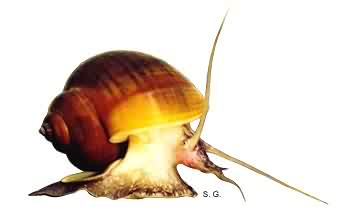 |
| Pomacea flagellata erogata. |
|
Habitat Food Life cycle Communication Predators Egg defences Mating Egg deposition |
| Habitat |
Apple snails inhabit a wide range of ecosystems from swamps, ditches and ponds to lakes and rivers. Not every species has similar preferences. However, most apple snails prefer lentic waters above turbulent water (rivers). Click here to see a photograph of the natural habitat of Pomacea canaliculata (province of Buenos Aires, Argentina).
|
|
The lung/gills combination reflects
an adaptation to oxygen poor water conditions often present in swamps and shallow
water. Oxigen is reduced by to decay of organic materials like dead vegetation
and high temperatures. Their lung prove very useful to survive in these harsh
conditions.
The shell door (operculum) / lung
combination increases the ability to survive periods of drought not uncommon
in swamps and small ponds in dry seasons. The snails bury themselves into the
substrate decrease their metabolism and enter a period of aestivation. Some
genera like Felipponea and Asolene
in South America and some Pila species in Asia
have thick and heavy shells as adaptation to streaming habitats.
One thing all apple snail have in common: the need (sub-)tropical temperatures
(also see the map at the species section).
No Ampullarriidae species survives in area's were the temperature drops below
10°C in the winter months.
Respiration isn't the only function of the lung, it also enables the snails
to adjust the buoyancy level (floating level). Without a filled lung, the gracious
movements of the snails under water would be impossible. The weight of the shell
would let them sink to the bottem like a stone. When the oxygen tension of the
water drops and the snails are forced to use aerial respiration, apple snails
often start to float to remain at the surface.
| Food |
Apple snails are not selective and eat almost everything available in their environment. In general they prefer soft and digestible vegetation. Tougher plants and algae are consumed as long as they are able to grasp pieces of with their radula (rasp tongue). Although the radular system is nearly identical throughout the different species, some have stronger and larger teeth on the radula than others. The species with thin and small teeth (like Pomacea diffusa) are unable to penetrate the tougher vegetation and specialise in death and soft plants. When there is not enough food available in the water, apple snails can profit from their amphibian life style to leave the water in search for food.
|
|
An interesting strategy used by apple snails to attain food is exhibited when
the food is floating on the surface (surface film feeding). In that case the
snail crawls to the surface and forms a foot-funnel
in to trap particles from the surface. To attract more floating food, the snail
makes the same movement with its foot as it does for walking with the front
part of the foot. The middle part and the tail of the foot, the snail remain
attached to the side or an object near the surface. Once the funnel is filled,
the snail brings its head in the funnel and eats the collected material. Behaviour
is known as ciliary feeding. There are indications surface feeding povides proteins
from the protein monolayer often present on the surface of quiet bodies of water.
This thin layer is often visible as an oil-like reflection on the surface and
is produced by and consists of microorganisms.
Although apple snails are mainly vegetarian, many species are known to predate on other snails and their eggs. Predation on the eggs of other snails is quite common, while predation on other snails is mostly exhibited at starvation. Occasionally it's showed when there is abundance food. In extreme, prolonged starvation apple snails are known to deploy cannibalistic behaviour. Two techniques are used to devour other snails: attacking the prey by introducing the proboscis (head/mouth) into the aperture of the victim and eating the flesh or by gnawing holes into the victim's shell in several stages with the radula and eating the exposed tissues. The first attack strategy, which only works on shells with large opening (for example Bulinus sp.), is applied by smaller species like Marisa cornuarietis, while the larger apple snail species (like Pomacea flagellata and Pomacea canaliculata) also use the second option enabling them to predate on Planorbids as well (for example Biomphalaria sp.) as these snails are otherwise able to escape predation when they withdraw deeply into their shell upon attack.
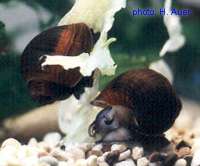 Pomacea flagellata erogata eating lettuce. (picture not licenced under creative commons) |
The predation rate differs between species. The appetite of Marisa cornuarietis
for other snails is about 10 times that of Pomacea canaliculata.
Apple snails are opportinustic and even consume all kinds of dead animals like
dead fish, frogs, crustaceans and insects and eggs (fish, frogs, snails etc.).
Since the high nutritional value of this alternative food source is high, this
behaviour fits well in their survival strategy.
| The life cycle of apple snails |
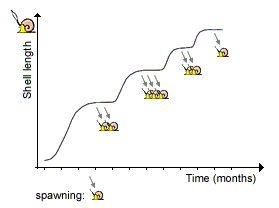 Growth and reproduction are alternated during life in both male and female Pomacea canaliculata snails. (more info: Estebenet, Biocell 2002) |
Life cycle
The life cycle of apple snails is determined by the availability of food and
the temperature of the water. At high temperatures and abundance of food, some
apple snail species exhibit a very short life
cycle of less than three months and are reproductive throughout the whole
year.
In though conditions, where the snails are faced with food shortages and even
periods of drought, apple snails have longer life cycles of only one reproductive
period in spring and early summer.
Not only the environmental factors as food and temperature are important as
species specific properties play a role as well. Some species have an aestivation
period, whereas other species don't, even when they are kept under the same
environmental conditions.
Growth and reproduction are alterated throughout the life cycle of the apple
snail.
This can be observed with Pomacea
canaliculata snails, raised with plenty of food and a temperature cycle
(day/night) of 9-29°C. During such experiment (figure at the left), the
hatchlings start to grow fast in the first months. Then the growth rate decreases
and comes to a complete halt (maturity is reached). At this timepoint, the snails
become sexually active and egg clutches are deposited. After one or more spawnings,
the snails start grow again at high rate until the next reproductive period
begins. The reduced growth during the reproductive periods cannot attributed
solely to the costs of mating and the production of sperm and eggs: Growth arrest
is also present in snails raised without a mating partner.
Recommended reading: Estebenet
2002
Active periods and aestivation
As said before apple snails can stay active throughout the year or have a period
of aestivation depending on the environmental conditions. The main factors that
determine the activity of apple snails are the temperature, the amount of rain
and the availability of food, with the first two as most important. Light intensity
or photoperiod has shown to be of little or no importance. During aestivation,
the snails bury in the mud and their metabolism slows down. The snail species
that aestivate in the dry mud need to reduce their oxygen consumption, as this
is hardly available in dry mud. To solve this problem, the snails switch from
the normal aerobic respiration to partly anaerobic respiration (anaerobic glycolysis).
The disadvantage if this metabolistic pathway is the production of lactic acid.
This acid is neutralised with calcium and the resulting calcium lactate is stored
in food of the snail.
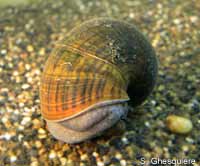 Inactive Pomacea canaliculata snail. |
The season in which the apple snails aestivate depends on the circumstances.
In areas with a dry and a wet periods, they aestivate during the dry season
until the rains begin. Some apple snails, particular of the Pila
genus, can aestivate for prolonged times in the mud. For example the South Indian
apple snails Pila virens is known
to survive aestivation periods of two years and even longer. Pila ampullacea
and Pila pesmei aestivate
deep into the mud (up to im depth). The Pila genus
has a thick and calcified operculum, possibly an adaptation to the dry seasons
in Asia. While most species simply hide in the mud, being only covered by a
small amount of material, some species like Pila globosa
actively bury themselves deep in the ground to depts of 50 to 80 cm.
Apple snails that inhabit areas without such distinctive dry-wet seasons, have
a more temperature regulated life cycle and occasionally hibernate if the food
availability decreases in the cold season. These snails also hide in the mud.
The increase in ambient temperature in spring and summer triggers the snails
to reappear. The reproductive starts mostly immediately with the onset of spring.
Apple snail species that live in environments with food and water available
throughout the year, like in tropical forests, do not show a well-defined aestivation
period, although their activity can vary.
| Snail-snail communication |
Not much is known about the snail-snail communication. They possibly communicate with chemical substances. A strong indication of this is when the female snails are ready to mate, the male snails are attracted to her even in complete darkness.
| Predators and the techniques used by apple snails to avoid them. |
As apple snail are a popular food source for various
animals like birds, turtles, fishes, insects and crocodiles, it is not surprising
that they have developed several techniques to avoid predation.
The most important enemy of the apple snail is man. They are collected to be
used as a food source and by collectors for their interesting shell.
Amongst the naterual enemies are the snail kite and Limpkins. These birds are
found in range from Florida through the Antilles and South America. Besides
birds other animals feed on apple snails. The caiman lizard even feeds exclusively
on these snails and has specialised teeth to crush the shell. Other animals
like fishes, insects and mammals occasionally predate on apple snails.
In area's where small rodents like rats feed on apple snails, the danger of
infection with the rat lungworm (Angiostrongylus cantonensis) exists. This
nematode parasite needs both the apple snail and rodents to complete it's life
cycle. The snail serves as intermediate host, while rodent is the main host.
Ingestion of raw, infected snails can cause serious illness in man.
To give an idea of which animals are enemies for the apple snails, a number
of know predators is listed below.
| List of Apple snail predators: | ||
|
One of the basic defence mechanism of apple
snails is to avoid detection by possible predators. This technique consists
of camouflage: the shell colour (green to brown) resembles the vegetation
and the banding pattern breaks the shell in smaller parts, less visible between
branches and stems of vegetation. The yellow variety of apple snails available
in the aquarium trade is much less common in the wild as snail-eating animals
easily spot these snails. Protection against small predators like insects (for
example water bugs) and small fish consists of retracting the body into
the shell and closing the shell with the operculum (shell door).
Apple snails also adopt their behaviour to cope with predators that eat their
tentacles, as many fish tend to do by keeping their head and tentacles under
their shell. They also wiggle their shell from side to side to remove
insects and other possibly dangerous animals from their shell. Apple snails,
however, do not very often use this wiggling method, it is common in pond snails.
The defence techniques described above are effective against a great number
of predators. Once spotted by a larger predator these techniques are ineffective
though and the snails (from the genus Pomacea)
rely on their main defence behaviour: drop-off and burial. In other
words: once the apple snail is alarmed, they loosen their grip and drop to the
bottom, where they bury on the spot or crawl until they contact a object like
a stone or some twigs and bury close to this. Burial against an object may be
advantageous as it makes the snail more difficult to grasp. The burial itself
achieved by alternating extension of the foot with pulling the shell down into
the substrate and within 5 to 10 minutes the snail can bury themselves completely.
The stimuli at which apple snails exhibit this drop-off and burial alarm
response is triggered mechanical and/or chemical.
Mechanical disturbance involves sudden water flow and vibrations. The sensitivity
for apple snails to respond to this stimuli varies amongst the species. Pomacea
paludosa is for example far less
sensitive than Pomacea glauca.
Also the age and size of the apple snail determines its reaction to a mechanical
disturbance: young and little snails are less reactive compared with their older
counterparts. Once little snails are triggered, they often react with drop-off
without burial after it.
Chemical stimuli that invoke an alarm response (drop-off and burial) consist
of the juice of crushed apple snails of the same (intraspecific) or a close
related (interspecific) species and the odour of predators like turtles. The
alarm response to snail juice is a remarkable feature in apple snails
that enables them to detect actively foraging predators in close distance and
react to it by a drop-off and burial before being detected. Of course this detection
mechanism only works when the predator crushes its victims and it is not effective
when the predator swallows them whole or takes them out the water like some
birds do. The opposite occurs as well: the juice of another snail invokes feeding
behaviour, mainly in younger snails. In such case the snails are rather attracted
instead of alarmed. The mechanical disturbances of predator activity, however,
still invokes an alarm response.
The alarm response to odours of predators is a fascinating adaptation
against predation shown in apple snails. It appears to be specific to certain
predators that inhabit the same area as the apple snail and is identical in
form shown to (intraspecific) snail juice: drop-off and burial. The sensitivity
to the odour of certain predators appears to be well developed before the snails
hatch from the eggs and is possibly further enhances due conditioning at a later
stage. In the never-ending battle between predator and prey, apple snails have
fine-tuned their response to specific odours. For example Pomacea paludosa
snails only react to the odour of the musk turtle (sternotherus minor)
when they are young and once the snails have grown to a weight of 3 grams, they
don't show a alarm response to this turtle. At this weight they are too big
to be eaten by the musk turtle. This weight related reactivity to certain odours
is not shown with the odour of the snapping turtle (Chelydra serpentina),
which is able to eat a larger snails as well. This observation supports the
highly specific development of defence mechanisms against predators.
Predators like fish and frogs do not cause a drop-off and burial response by
odour, possibly because they simply do not produce enough odours. Another example
of refined alarm response is illustrated by light depend alarm response to odours
(burial at day, no alarm response at night). Many predators depend on their
vision to locate apple snails, so only during daylight a reaction is necessairly.
No evidence has been reported for a snail-snail alarm response in which apple
snails alarm each other by releasing alarm messages. This would be ineffective,
as such release of alarm messages would cause a whole cascade of alarm messages
throughout the environment, alarming all snails, even those far away from the
predator.
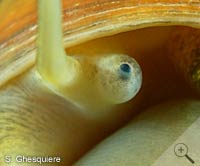 Eye on eye stalk of Pomacea canaliculata. |
Vision is not important for apple snails as mechanism to detect predators or other danger. This is supported by the fact that apple snails do not show an alarm response to sudden light changes or moving objects above the water surface. A possible reason why apple snails do not rely on their vision could be the limited ability to form images with their eyes, let alone to distinguish a predator from other objects. If every sudden light change would trigger an alarm response, apple snails would suffer from many 'false' alarms. The combined sensitivity to mechanical disturbance and chemical stimuli (snail juice and predator's odour) appears to be sufficiently adequate for an apple snail to survive.
| Egg defences |
It is remarkable how visible the egg clutches of many apple snail species are. The pinkish to reddish eggs are attached on the contrasting green vegetation submerging from the water (in the genus Pomacea). This makes them visually inconspicuous from many meters away for predators. This suggests a possible warning function for unpalatability. Field evidence of this unpalatability is provided by the fact that almost all animals foraging in habitats where the apple snails live, ignore these eggs: from fish to birds, they all leave them alone. Also when apple snail eggs are offered to captive predators, they often try to eat them at first, but refuse them after repeated feeding.
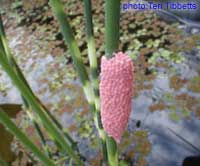 Apple snail eggs on emerging vegetation (Pomacea canaliculata). (picture not licenced under creative commons) |
Another interesting evidence for the unpalatability is the feeding behaviour
of limpkins on apple snails. Limpkins do feed on female apple snail with well-developed
albumen (yolk) gland, but they discard
this organ before eating the snails. Rejection of the albumen gland is also
observed when offering apple snail meat to fish. This suggests that substances
in yolk, not in the scale cause the unpalatability of the eggs. Researchers
(humans) who tasted the eggs described them as "completely tasteless at
first, but after chewing them for about half a minute, an overwhelming bitter-nauseating
flavour assaulted the rear portion of the palate" (SNYDER,
N. F. R. & SNYDER, H. A. 1971). Besides their unpalatability, some
apple snail species prefer to deposit their eggs on
vegetation covered with thorns, making them more difficult catch for a predator.
There are also apple snail species that lay greenish eggs like Pomacea glauca,
Pomacea pyrum and others, while the apple snail from
the genus Pila have white eggs. The green colour
is a rather camouflage to render the eggs invisible for predators.
The aquatic eggs from the genera Asolene (Asolene),
Lanistes and Marisa
are protected by a gelatinous slime surrounding the eggs. These eggs are less
visible than their aerial cousins because their transparance, and they are deposited
on less visible places (between vegetation). A particular interesting way to
protect the eggs and the young snails against drought and predators is shown
by Pomacea urceus. This
snail lays its orange eggs at the inside of the shell near the aperture. The
eggs are brooded in this incubation chamber closed of with the mother's operculum
(shell-door), while the snail aestivates in the dry mud during the dry season.
The young snails hatch inside the mother's shell and crawl around until the
rainy season starts.
| Mating behaviour |
When the snails mate, the male snail approaches the female from behind and creeps on her shell. Once he has reached the last whorl at the front of the female's shell, he secures her aperture by grasping her with his penial sheat and inserts his thin, whip-like penis in her genital tract.
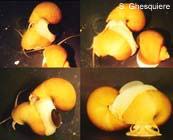 Male snail getting on the female. |
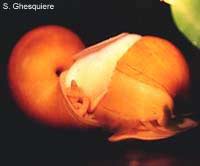 Mating snails (Pomacea diffusa). |
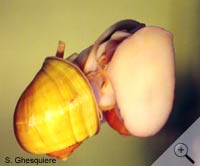 Male at the left inserts his penis in the female (Pomacea diffusa). |
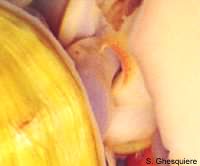 Close up of the picture at the left. |
The mating snails remain in this position during the entire period of copulation:
between one hour to a whole day. The total duration of the copulation varies
between the species: 1-3 hours in case of Pomacea
haustrum to 1-6 hours in Marisa cornuarietis.
During copulation the male retracts his head under his shell, while the female
snail may still move around and frequently continuous with eating. The male
snail is quite persistent while mating and doesn't loose grip even if the couple
is lifted from the water.
The female snail can store active sperm for months in her genital tract enabling the female apple
snail to reproduce even if she does not meet a male for the months thereafter.
Although apple snails don't interbreed with other (apple snail) species they
can often be seen to mount each other. For example Pomacea diffusa sometimes mounts
Pomacea canaliculata,
and vise-versa (latter observated by Pam Spencer).
| Egg deposition (oviposition) |
The egg laying behaviour of apple snails can be divided in two groups: the ones that deposit the eggs above the waterline and the ones that produce aquatic eggs.
| Movies (MPEG1): - Egg deposition (Pomacea diffusa) (267kb) |
Egging deposition in the genera Pomacea,
Asolene (Pomella)
and Pila:
The female snail climbs out of the water, usually during the night or the early
morning to deposit the eggs on a stem of emergent aquatic vegetation, a trunk,
a rock or in case of Pila snails (like Pila
globosa) on the ground. In the latter
case the eggs are laid in a natural depression or a special pit made for this
purpose by the snail with the shell border and the foot. Approximately 5 to
80 centimetres (2-32 inch) above the waterline (depending on the species and
habitat) the snail relaxes the columellar muscle (the muscle that is used to
retract the body into the shell) but remains attached to the surface with her
foot. The eggs are deposited one by one or sometimes in pairs as they come out
of the genital tract and are guided over the body of the snail in a special
groove: the ovipositor, after which they are added to the lower edge of the
clutch.
|
|
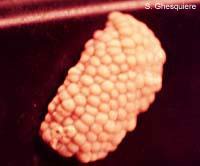 Eggs, Pomacea diffusa, 2 hours old. |
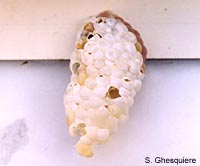 Pomacea flagellata eggs after hatching. Only a few eggs did not hatch and some little snails did not manage to get out in time. |
In approximately every 30 seconds a new egg appears and is added to the growing
eggs clutch. Besided the transport of the eggs from the genital tract towards
the egg mass, the foot also keeps the fresh eggs together and determines the
shape of the clutch. During the egg deposition, the snail gradually descends
backwards and when she is finished, she releases her hold and drops directly
back into the water. The total time needed to deposit a clutch of eggs varies
from 1 to 6 hours. When the female snail leaves the water to lay her eggs, she
is very aware of the surroundings and the slightest disturbance causes her to
drop back in the water. Once the spawning starts, the snail only drops back
at heavy disturbance. Observation of the spawning snail is easy at this point.
Sometimes the eggs are laid spread over two days; the first part is laid on
the first day and the other half on the second day. The total number of eggs
laid at once can vary from 100 to 1000 (species dependent). When first laid
the eggs are soft and have a milky white to pale orange appearance (depending
on the species). Their definite colour appears when they dry and harden during
the first day. During the development of the eggs, the colour changes: the eggs
gradually become paler and whiter and prior to hatching the eggs are almost
white with dark spots (the young snails).
As mentioned before, Pomacea urceus
is an exception: the snails copulate at the start of the dry season (December-January)
and thereafter they bury in the mud. The female deposits her eggs (50 to 200)
outside her operculum, where the clutch is attached to the distal wall of the
aperture. The female buries herself with the aperture faced down, forming a
brood-chamber for the eggs. The snails are cemented in this position, while
the young snail hatch in January-February and aestivate in the brood chamber
until the rain season starts in May.
Egg deposition in the genera Asolene (Asolene),
Felipponea, Lanistes,
Marisa and possibly also Afropomus
and Saulea (anyone info about this?):
These eggs in are laid on objects (plants, stones, and trunks) below the surface.
First after deposition, the soft, transparant eggs are relatively small, but
increase in size during the first days due to the uptake of water. The eggs
itself are embedded in a gelatinous mass to protect them.
When the young snails have eaten all the yolk inside
the eggs, they finally eat their way out. During the first days after hatching,
the young snails feed on the remains of the egg-mass.
|
|
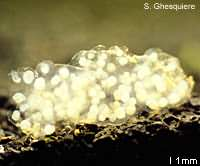 Eggs in gelatinous mass, Marisa cornuarietis, 2 days old. |
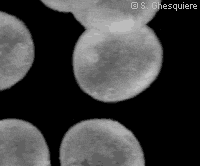 After 10 days the young Marisa cornuarietis snails are visible as small, moving spots inside the eggs. (movie above plays at 5x speed) More in the 'embryology' section. |
|
Except where otherwise noted, this page is licensed under a Creative Commons Attribution-NonCommercial-ShareAlike 2.5 License . http://www.applesnail.net |
|